Jochen L. Cremer
Transferable Graph Learning for Transmission Congestion Management via Busbar Splitting
Oct 23, 2025Abstract:Network topology optimization (NTO) via busbar splitting can mitigate transmission grid congestion and reduce redispatch costs. However, solving this mixed-integer non-linear problem for large-scale systems in near-real-time is currently intractable with existing solvers. Machine learning (ML) approaches have emerged as a promising alternative, but they have limited generalization to unseen topologies, varying operating conditions, and different systems, which limits their practical applicability. This paper formulates NTO for congestion management problem considering linearized AC PF, and proposes a graph neural network (GNN)-accelerated approach. We develop a heterogeneous edge-aware message passing NN to predict effective busbar splitting actions as candidate NTO solutions. The proposed GNN captures local flow patterns, achieves generalization to unseen topology changes, and improves transferability across systems. Case studies show up to 4 orders-of-magnitude speed-up, delivering AC-feasible solutions within one minute and a 2.3% optimality gap on the GOC 2000-bus system. These results demonstrate a significant step toward near-real-time NTO for large-scale systems with topology and cross-system generalization.
Towards Generalization of Graph Neural Networks for AC Optimal Power Flow
Oct 08, 2025Abstract:AC Optimal Power Flow (ACOPF) is computationally expensive for large-scale power systems, with conventional solvers requiring prohibitive solution times. Machine learning approaches offer computational speedups but struggle with scalability and topology adaptability without expensive retraining. To enable scalability across grid sizes and adaptability to topology changes, we propose a Hybrid Heterogeneous Message Passing Neural Network (HH-MPNN). HH-MPNN models buses, generators, loads, shunts, transmission lines and transformers as distinct node or edge types, combined with a scalable transformer model for handling long-range dependencies. On grids from 14 to 2,000 buses, HH-MPNN achieves less than 1% optimality gap on default topologies. Applied zero-shot to thousands of unseen topologies, HH-MPNN achieves less than 3% optimality gap despite training only on default topologies. Pre-training on smaller grids also improves results on a larger grid. Computational speedups reach 1,000x to 10,000x compared to interior point solvers. These results advance practical, generalizable machine learning for real-time power system operations.
Customising Electricity Contracts at Scale with Large Language Models
May 26, 2025Abstract:The electricity system becomes more complex, connecting massive numbers of end-users and distributed generators. Adding or removing grid connections requires expert studies to align technical constraints with user requests. In times of labour shortages, carrying out these studies represents a significant amount of time that engineers at system operators spend in planning departments. As time is limited, only standard block connectivity contracts can be offered to end-users, or the requests pile up. Even if offers are made, these often do not perfectly match the user's requirements, leading to overpaying or underusing the grid capacity. This paper investigates whether end-users can negotiate individual, flexible time-of-use contracts directly with the grid using Large Language Models (LLM) in chats at scale. The LLM-based chat has direct access to a model of the grid and studies the grid's technical constraints just as an expert engineer. The advantage of this system is that end-users can directly interact with grid models through natural language; no intermediate is needed to service, analyse, study, assess, advise, consult and engineer. This initial study paves the way toward developing this tailored LLM system, resulting in possible high-efficiency gains for grid planning and customer management.
A Pioneering Roadmap for ML-Driven Algorithmic Advancements in Electrical Networks
May 28, 2024



Abstract:To advance control, operation and planning tools of electrical networks with ML is not straightforward. 110 experts were surveyed showing where and how ML algorithmis could advance. This paper assesses this survey and research environment. Then it develops an innovation roadmap that helps align our research community towards a goal-oriented realisation of the opportunities that AI upholds. This paper finds that the R\&D environment of system operators (and the surrounding research ecosystem) needs adaptation to enable faster developments with AI while maintaining high testing quality and safety. This roadmap may interest research centre managers in system operators, academics, and labs dedicated to advancing the next generation of tooling for electrical networks.
End-to-End Learning with Multiple Modalities for System-Optimised Renewables Nowcasting
Apr 14, 2023Abstract:With the increasing penetration of renewable power sources such as wind and solar, accurate short-term, nowcasting renewable power prediction is becoming increasingly important. This paper investigates the multi-modal (MM) learning and end-to-end (E2E) learning for nowcasting renewable power as an intermediate to energy management systems. MM combines features from all-sky imagery and meteorological sensor data as two modalities to predict renewable power generation that otherwise could not be combined effectively. The combined, predicted values are then input to a differentiable optimal power flow (OPF) formulation simulating the energy management. For the first time, MM is combined with E2E training of the model that minimises the expected total system cost. The case study tests the proposed methodology on the real sky and meteorological data from the Netherlands. In our study, the proposed MM-E2E model reduced system cost by 30% compared to uni-modal baselines.
Deep Statistical Solver for Distribution System State Estimation
Jan 04, 2023



Abstract:Implementing accurate Distribution System State Estimation (DSSE) faces several challenges, among which the lack of observability and the high density of the distribution system. While data-driven alternatives based on Machine Learning models could be a choice, they suffer in DSSE because of the lack of labeled data. In fact, measurements in the distribution system are often noisy, corrupted, and unavailable. To address these issues, we propose the Deep Statistical Solver for Distribution System State Estimation (DSS$^2$), a deep learning model based on graph neural networks (GNNs) that accounts for the network structure of the distribution system and for the physical governing power flow equations. DSS$^2$ leverages hypergraphs to represent the heterogeneous components of the distribution systems and updates their latent representations via a node-centric message-passing scheme. A weakly supervised learning approach is put forth to train the DSS$^2$ in a learning-to-optimize fashion w.r.t. the Weighted Least Squares loss with noisy measurements and pseudomeasurements. By enforcing the GNN output into the power flow equations and the latter into the loss function, we force the DSS$^2$ to respect the physics of the distribution system. This strategy enables learning from noisy measurements, acting as an implicit denoiser, and alleviating the need for ideal labeled data. Extensive experiments with case studies on the IEEE 14-bus, 70-bus, and 179-bus networks showed the DSS$^2$ outperforms by a margin the conventional Weighted Least Squares algorithm in accuracy, convergence, and computational time, while being more robust to noisy, erroneous, and missing measurements. The DSS$^2$ achieves a competing, yet lower, performance compared with the supervised models that rely on the unrealistic assumption of having all the true labels.
Learning to run a power network with trust
Oct 21, 2021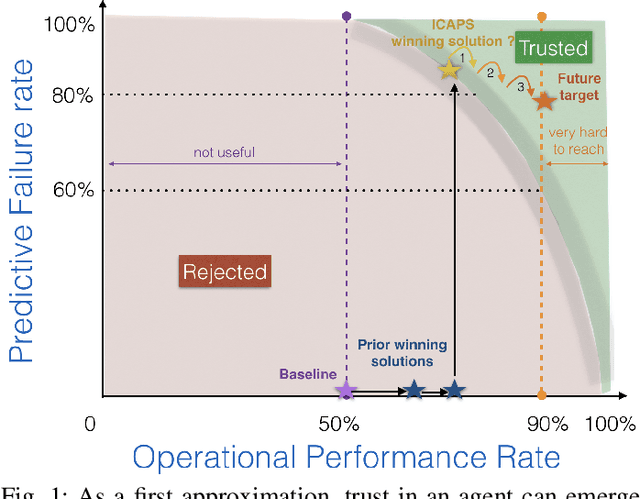
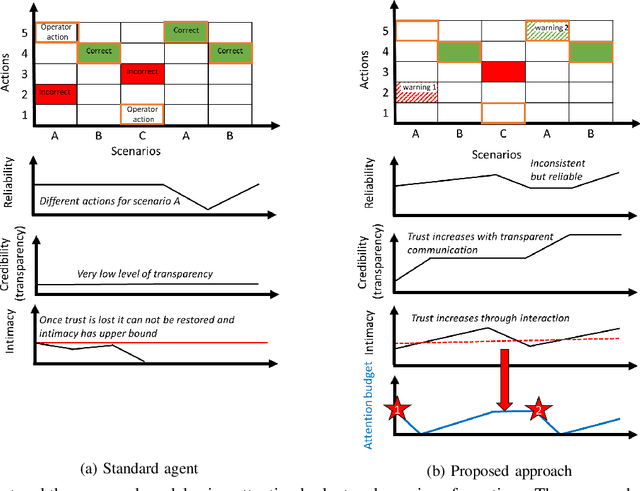
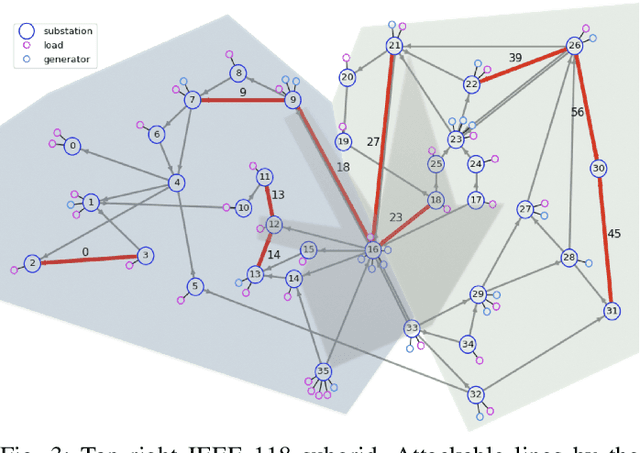
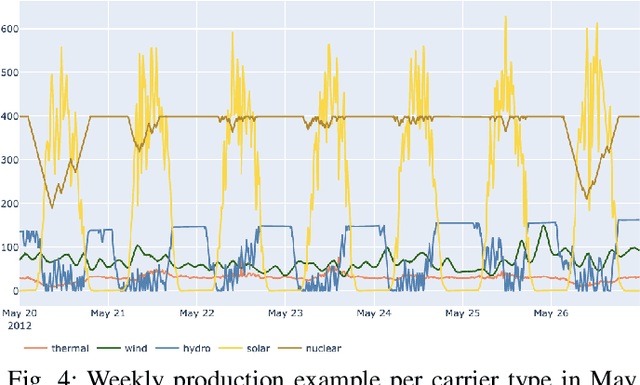
Abstract:Artificial agents are promising for realtime power system operations, particularly, to compute remedial actions for congestion management. Currently, these agents are limited to only autonomously run by themselves. However, autonomous agents will not be deployed any time soon. Operators will still be in charge of taking action in the future. Aiming at designing an assistant for operators, we here consider humans in the loop and propose an original formulation for this problem. We first advance an agent with the ability to send to the operator alarms ahead of time when the proposed actions are of low confidence. We further model the operator's available attention as a budget that decreases when alarms are sent. We present the design and results of our competition "Learning to run a power network with trust" in which we benchmark the ability of submitted agents to send relevant alarms while operating the network to their best.
Sample-Derived Disjunctive Rules for Secure Power System Operation
Apr 09, 2018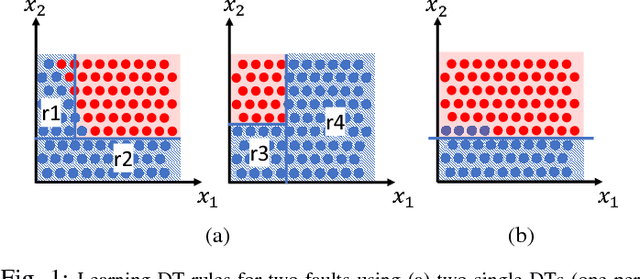
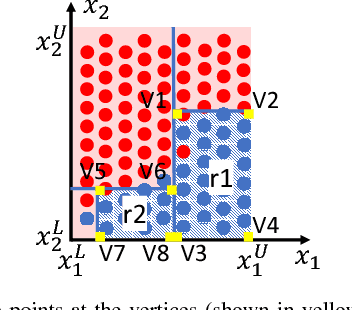
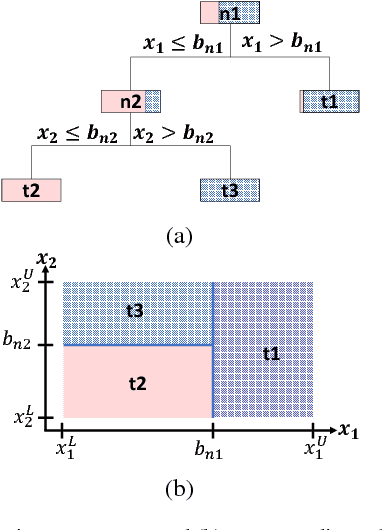
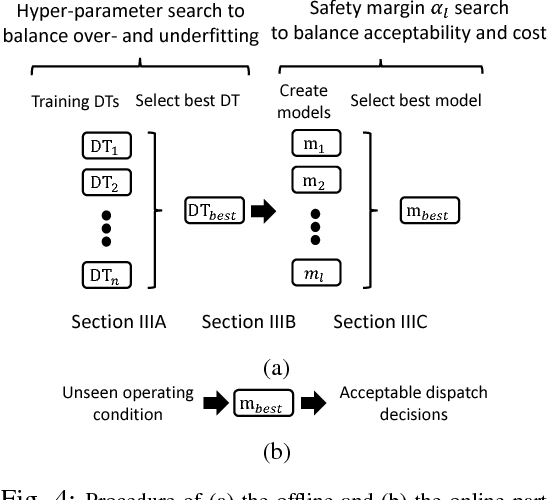
Abstract:Machine learning techniques have been used in the past using Monte Carlo samples to construct predictors of the dynamic stability of power systems. In this paper we move beyond the task of prediction and propose a comprehensive approach to use predictors, such as Decision Trees (DT), within a standard optimization framework for pre- and post-fault control purposes. In particular, we present a generalizable method for embedding rules derived from DTs in an operation decision-making model. We begin by pointing out the specific challenges entailed when moving from a prediction to a control framework. We proceed with introducing the solution strategy based on generalized disjunctive programming (GDP) as well as a two-step search method for identifying optimal hyper-parameters for balancing cost and control accuracy. We showcase how the proposed approach constructs security proxies that cover multiple contingencies while facing high-dimensional uncertainty with respect to operating conditions with the use of a case study on the IEEE 39-bus system. The method is shown to achieve efficient system control at a marginal increase in system price compared to an oracle model.
 Add to Chrome
Add to Chrome Add to Firefox
Add to Firefox Add to Edge
Add to Edge